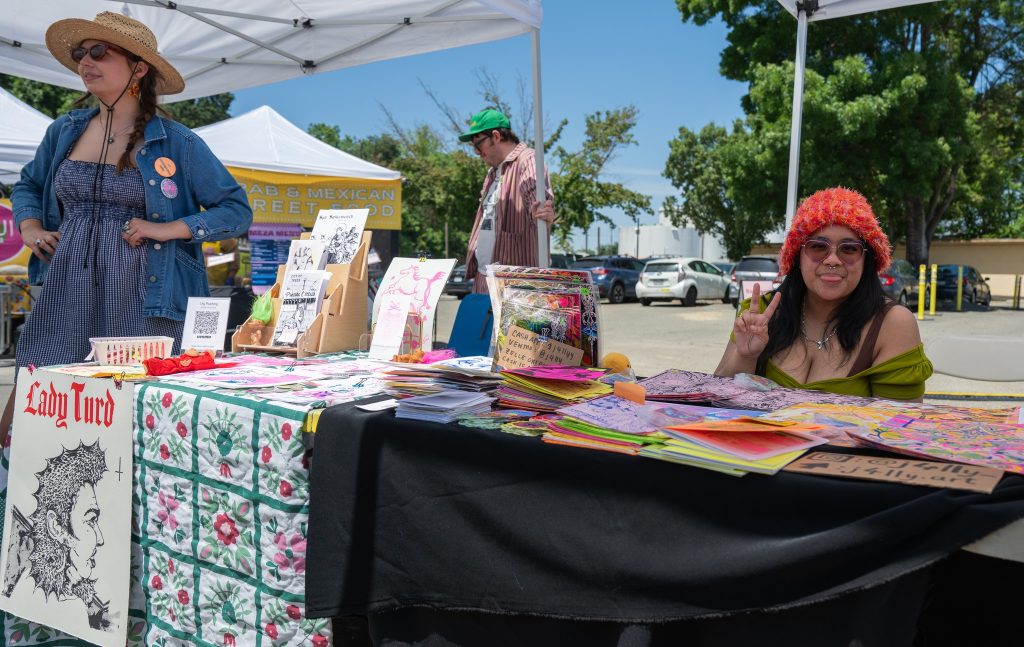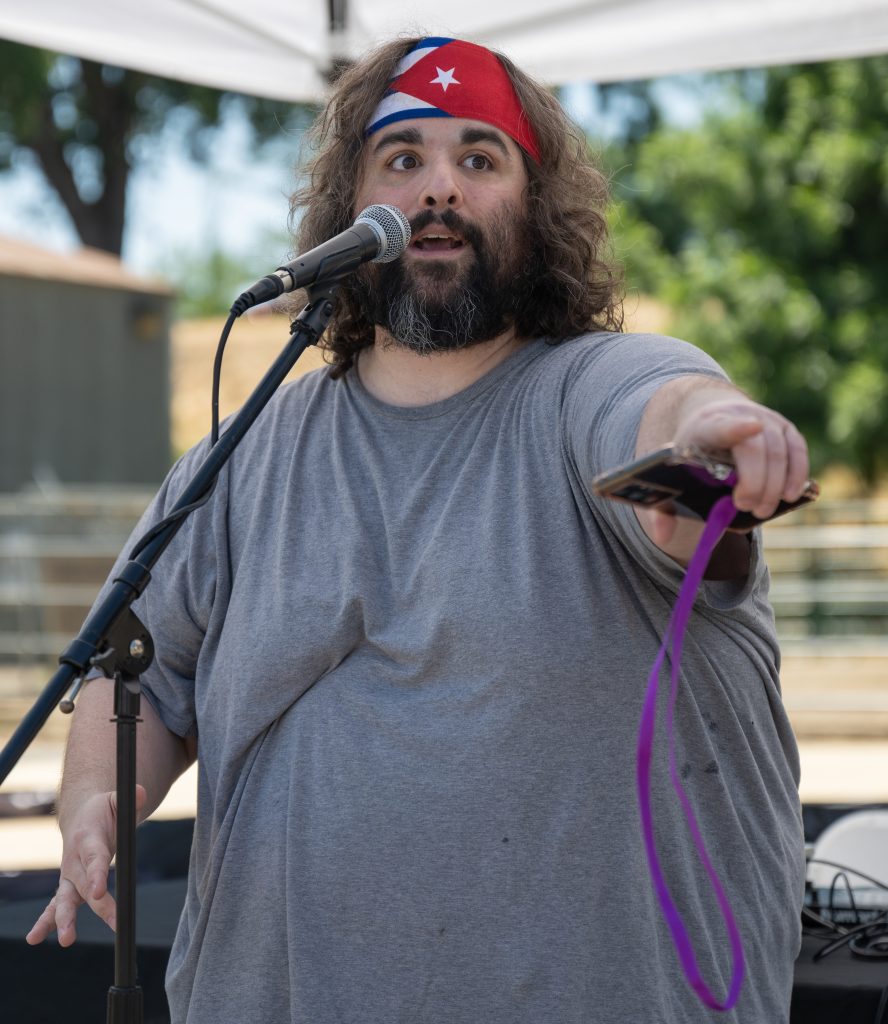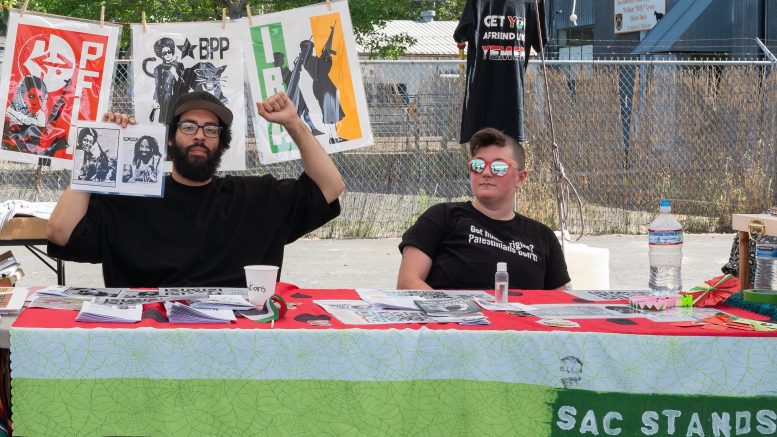By Marie-Elena Schembri
Over 30 tables lined the parking lot outside the Latino Center for Arts and Culture on Front Street in Sacramento on Sunday, May 19 for the center’s inaugural Zine Fest. The event aimed to increase inclusivity and accessibility for underrepresented artists, particularly creators of color, LGBTQ+, neurodivergent and disabled artists.
Organizers offered affordable vendor spaces and prioritized applications aligning with the inclusive mission to showcase “accessible art, and art for the people and the culture surrounding these communities.”
“Our goal is to eliminate as many barriers of entry as possible,” said Jorge Quintana, LCAC director of communications. “It doesn’t matter if you’re an artist that’s been working for 50 years or an artist that just started, as long as you can bring your own materials, we’ll have a table for you. We’re here for you to have a space to promote your own work.”
Quintana added that providing space to people of color, particularly Latinos, is important because, historically, Latinos have not had access to safe spaces to sell their work or learn new artforms and techniques.
“So oftentimes there’s so many barriers of entry when we go into learning arts and then even selling, displaying your art form. … So we have a space and we want people to use it and we want to make sure that as they’re using it, they’re not worried about how much they’re going to have to pay,” Quintana said. “They’re instead being able to focus on what they’re able to produce, the quality of it, and essentially just going off on their journey as professionals.”

For Oakland-based Malaysian cartoonist Cynta Camilia, who moved to the United States in 2016, the sliding-fee model made it possible for her to attend and sell her art. Camilia paid no more than $25 for her booth, which might have cost $70 or more at a larger event, she said.
“I’m an international student, so I don’t make money,” Camilia said. Her risograph prints and zines were all priced under $20. “And I get a lot of people telling me like, ‘Oh, you’re selling your stuff so cheap.’ And I’m like, ‘This is actually cheap to you. It’s affordable for me.’ And I also [like to] have people to be able to buy my art.”
Justin Mata, the LCAC board member who proposed the Zine Fest, saw it as a way to connect with new audiences and expand the center’s reach. The center was originally called La Raza Bookstore and was founded in 1972 during the Chicano Civil Rights Movement, before being renamed in 2014 to the Latino Center of Art and Culture.
“I thought this was the type of energy that is parallel to the work that we’re doing in [the] Latino Center and that we could do something that was an additive to Sacramento that would not be in competition — not be an either-or for any other event, whether it was a zine fest or any other kind of event —but rather something where we did it the Latino Center way and bring a new community into the Latino Center and also influence the community with the work that we do,” Mata said.
Mata co-coordinated the event with curator and printmaker Jazel Muñoz, who contributed her experience with zine and printmaking events. For Muñoz, zine-making is an accessible art form.
“I think it’s more accessible because it’s for everyone. I think that in zines specifically, it’s self-published work and for me, I feel like there aren’t any rules whether or not you can speak to something or not,” Muñoz said.
For her, accessibility is about “having a voice,” which can often be a challenge for marginalized artists. Zines, according to Muñoz, provide opportunities for anyone with any skill level to share narratives from poetry to political works that might be censored in other avenues. And you can speak to those things that you’re passionate about or see that you want to share with the community.”

Muñoz curated the “Revolutionary Legacies” exhibition in the LCAC gallery, which included hand-printed posters by Eddie Lampkin, known as Printingainteasy, Gilda Posada and Ren Allathkani addressing political conflicts and cultural movements such as the Israeli-Palestinian conflict and Black Lives Matter.
The variety of zines on display reflected diverse voices and experiences, with topics ranging from personal struggles to cultural identity and social justice. Several booths featured artwork and zines expressing solidarity with Palestinians, including a booth that was shared between the community organization Sacramento Stands with Palestine and advocacy group Cell Block 2 City Block, where several copy-printed zines told the stories of Palestinian prisoners of war.
Also present were nonprofits Sacramento Native American Health Center, Community Health Works and 916 Ink, and the Sacramento Valley Tenants Union who brought a zine about tenant’s rights in Sacramento. Poetry and DJs also provided entertainment from a nearby stage and LCAC artists Ruben Reveles and Anna Morales gave tours of their studios.
Reveles, who identifies as a Chicanx digital artist and has had a studio at the center for several years, commented on the event, saying it involved “a different part of the community.”

While organizers aren’t sure yet if there will be a repeat of the event, it appeared to be a success all around, with hundreds of visitors throughout the day.
“This whole process has been really beautiful. Working with Jazel [Muñoz], working with the staff of the Latino Center, my fellow board members, it is always a thing that just brings me joy,” Mata said. “And so there was no way that it wasn’t going to be a beautiful thing for me. And I think that the sun is here, the vibes are right. Everyone that is presenting has just been, they’ve been beautiful humans. And I think that we are kind of matching each other in the energy that we bring.”
This story is part of the Solving Sacramento journalism collaborative. Solving Sacramento is supported by funding from the James Irvine Foundation and James B. McClatchy Foundation. Our partners include California Groundbreakers, Capital Public Radio, Outword, Russian America Media, Sacramento Business Journal, Sacramento News & Review, Sacramento Observer and Univision 19.


Be the first to comment on "Inclusivity at the forefront of Sac’s Latino Center of Art and Culture’s inaugural Zine Fest"